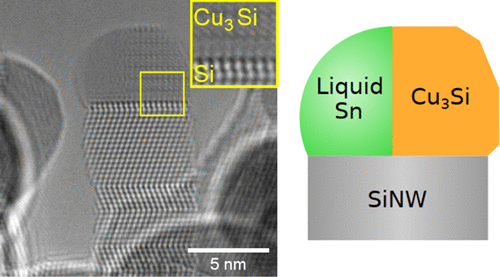当前位置:
X-MOL 学术
›
J. Phys. Chem. C
›
论文详情
Our official English website, www.x-mol.net, welcomes your
feedback! (Note: you will need to create a separate account there.)
Liquid-Assisted Vapor–Solid–Solid Silicon Nanowire Growth Mechanism Revealed by In Situ TEM When Using Cu–Sn Bimetallic Catalysts
The Journal of Physical Chemistry C ( IF 3.3 ) Pub Date : 2021-09-02 , DOI: 10.1021/acs.jpcc.1c05402 Éric Ngo 1 , Weixi Wang 1 , Pavel Bulkin 1 , Ileana Florea 1 , Martin Foldyna 1 , Pere Roca i Cabarrocas 1 , Jean-Luc Maurice 1
The Journal of Physical Chemistry C ( IF 3.3 ) Pub Date : 2021-09-02 , DOI: 10.1021/acs.jpcc.1c05402 Éric Ngo 1 , Weixi Wang 1 , Pavel Bulkin 1 , Ileana Florea 1 , Martin Foldyna 1 , Pere Roca i Cabarrocas 1 , Jean-Luc Maurice 1
Affiliation

|
We report on a silicon nanowire growth method that is based on the use of a dual-phase catalyst made of liquid Sn and solid Cu3Si, which results in a liquid-assisted VSS (LA-VSS) mechanism. The silicon atoms are brought by atomic hydrogen-assisted dissociation of silane molecules. We observe the growth in situ, in the transmission electron microscope, at atomic resolution. We show that the dual-phase catalyst favors the ⟨111⟩ crystallographic orientation. Each new Si(111) plane nucleates at the interface between the liquid and solid parts of the catalyst before propagating rapidly along the interface of Si top facet with the liquid part and slowly along the interface with the solid part. Moreover, we show that the structural properties of the Si nanowires, such as the growth direction and the twin density, can be controlled by adjusting the Sn/Cu ratio.
中文翻译:

原位 TEM 揭示了使用 Cu-Sn 双金属催化剂时的液体辅助蒸汽-固体-固体硅纳米线生长机制
我们报告了一种硅纳米线生长方法,该方法基于使用由液体 Sn 和固体 Cu 3 Si制成的双相催化剂,从而产生液体辅助 VSS (LA-VSS) 机制。硅原子是由硅烷分子的原子氢辅助离解产生的。我们观察原地生长,在透射电子显微镜中,在原子分辨率下。我们表明双相催化剂有利于 ⟨111⟩ 晶体取向。每个新的 Si(111) 平面在催化剂的液体和固体部分之间的界面处成核,然后沿着 Si 顶面与液体部分的界面快速传播,然后沿着与固体部分的界面缓慢传播。此外,我们表明可以通过调整 Sn/Cu 比来控制 Si 纳米线的结构特性,例如生长方向和孪晶密度。
更新日期:2021-09-16
中文翻译:

原位 TEM 揭示了使用 Cu-Sn 双金属催化剂时的液体辅助蒸汽-固体-固体硅纳米线生长机制
我们报告了一种硅纳米线生长方法,该方法基于使用由液体 Sn 和固体 Cu 3 Si制成的双相催化剂,从而产生液体辅助 VSS (LA-VSS) 机制。硅原子是由硅烷分子的原子氢辅助离解产生的。我们观察原地生长,在透射电子显微镜中,在原子分辨率下。我们表明双相催化剂有利于 ⟨111⟩ 晶体取向。每个新的 Si(111) 平面在催化剂的液体和固体部分之间的界面处成核,然后沿着 Si 顶面与液体部分的界面快速传播,然后沿着与固体部分的界面缓慢传播。此外,我们表明可以通过调整 Sn/Cu 比来控制 Si 纳米线的结构特性,例如生长方向和孪晶密度。











































 京公网安备 11010802027423号
京公网安备 11010802027423号